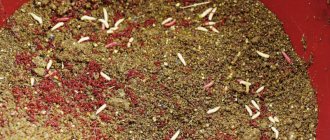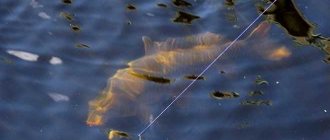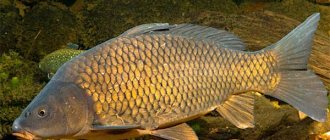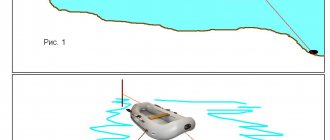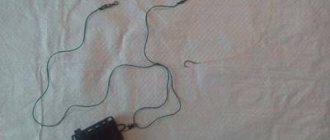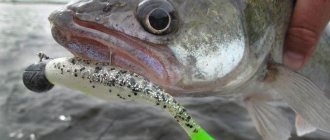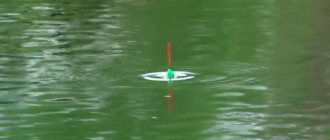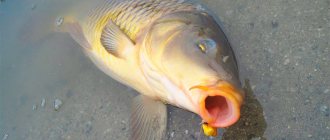Fishing from a boat
How to use electronic bite alarms? How to rationally arrange fishing rods? Fatal consequences. All these questions lead to the fact that most carp anglers tend to keep both feet on the ground, which should not be considered a disadvantage on lakes with hard shores. But on small bodies of water, where you cannot always reach the chosen place along the shore, overcoming the coastal swamp has fatal consequences.
The fact is that only those carps are caught whose paths lie within the range of conventional fishing gear. All the attention of “carp anglers” is directed to this fish; it is here that the carp faces a constant danger of being hit in the head with a heavy sinker while peacefully digging at the bottom. Therefore, carp “with experience” bite (if they bite at all!) extremely carefully.
I myself used to belong to the first “modern carp anglers” on such lakes. At first they were considered a heavenly place, where three to five carp could be tempted into temptation during the first half of the day. Then the bites became less frequent, shifting to the dark. And finally, the moment came when I was glad if I caught at least one carp in three days.
With an eye on virgin soil. Get in the boat and I promise you, you'll fish like the good old days again, as long as you get the hang of the virgin land. By this I mean places as far as possible from the shore, which no “stationary carp fisherman” can reach. Before settling on a particular place, spend the evening scouting out the body of water.
It is necessary to find out where the carp are located, whether rising bubbles are visible somewhere, whether the carp are frolicking on the surface, whether there are places where, when there is no wind, the algae sway, as if by a devilish delusion, whether bow waves are visible in the shallow water. You may also be able to detect indirect signs of the presence of carp.
Lure
There are two ways to feed carp.
Method one
Feed small portions of the place where the carp is supposed to be. The same baits and lures that are supposed to be used to catch carp are used as spot bait. These could be corn kernels, worms, green peas, maggots, etc. The food should be added in small portions, very carefully, so as not to make strong sounds, so as not to scare away the fish.
Method two
Preliminary feeding of a small part of the aquarium with homemade mixtures or porridges, using prepared balls molded by hand.
Store-bought mixtures are very popular among fishermen, as they are highly effective. This is due to the fact that they contain various fruit flavors, which carp cannot refuse.
You can learn how to prepare effective carp bait yourself by reading the relevant information on the Internet.
It is advisable to add fractions of the bait that you intend to use to your bait. These can be chopped worms, maggots, bloodworms, etc. They are mixed together with the bait, after which balls are molded from the entire mass and thrown into one place.
And here's what you need to know: Catching pike with live bait in different ways in summer and winter
Casts must be accurate and not deviate from the intended fishing location by more than 1 meter. In this case, the place is fed immediately, so as not to throw the bait later and not scare the carp.
Fishing from a boat
In clear water at the bottom, bowl-sized depressions are sometimes found, which clearly indicate that large carp have been burrowing here. In addition, you may encounter a vertical sinker or notice a sandbar or perch ridge using an echo sounder. Such places are rich in food, which carps know well.
From a boat you naturally have more choice than from shore. You can quietly approach any interesting place and study it thoroughly. Unlike casting with a slingshot, you can lower the bait directly to the selected point. On large bodies of water, I recommend laying small feeding tracks in different directions - this way you can attract carp to the main fishing spot.
Feed for several days, just as you usually do when fishing on the shore. Just to be on the safe side, you should increase the amount of bait by one and a half times in the expectation that you may find yourself among undeterred carp. Your fishing trip will begin with solving a difficult problem: how to anchor the boat?
In shallow water with a soft bottom, it is recommended to use the experience of our Hungarian friends: they stick two strong poles into the bottom to the left and right of the boat, due to which it wedges between them. Two lengths of rope will protect the boat from hitting the poles. It won't be a hassle, don't you think? You will learn about how much bait you need for carp fishing from this post .
Then try fixing your boat to a snag in the water, for example, to a fallen tree, or place it perpendicular to the edge of the reeds and tie tightly to the left and right, but not to individual stems, but to whole bunches. Every time you have to be surprised how well they hold the boat. In addition to this, throw one, or preferably two anchors (left and right) towards clear water.
Fishing from a boat in open water. In the event that you must go out into open water, a minimum of two anchors will be required. Even in the wind, you won't have much difficulty lowering the anchors right next to the boat. The greater the distance between them, the sharper the angle between the anchor rope and the boat and the more stable the anchors are held.
In shallow water it is enough to have 5-7 m of rope, and in depths over 5 m you will need 10-15 m. First lower the stern anchor into the water, then walk a distance of slightly more than half the length of the stern anchor rope. Drop the bow anchor here. Now pull the anchor rope at the stern to about halfway.
Fishing from a boat
In strong winds, the anchor rope in the direction of the wind should be noticeably longer, since more force is exerted on this anchor. The rope needs to be pulled tight. Just don’t forget about her in the heat of play! One more trick. But is it possible to raise two anchors and haul them out at the same time? There is one tricky trick: tie a large float, such as a pike float, to the middle of the anchor rope.
Then, during fishing, you will only have to release the rope fasteners in the boat. Overboard it (you'll pick it up again later), and go after the carp! By the way, it wouldn’t hurt for me to start fishing for my carp. I stand on the bow of the boat and win back meter by meter from him. Soon the body of the fish, like a gold ingot, begins to sparkle on the surface, then again plunges steeply into the depths.
I calmly look at my landing net. He is ready for battle and lies to my right. The advantage of fishing from a boat is that you can quickly select a line, get close to the carp and reduce the risk of it getting caught on any obstacles, be it branches, shells or rocks. In addition, with some luck, you can free the fish even if it tries to hide under a snag.
However, there is also a drawback: from an unanchored boat you will not be able to hold the carp if you want to slow it down a little in front of a field of water lilies. After all, the boat is not fixed and will not withstand the pressure of a strong fish. My carp stays in open water and the circles become smaller. I kneel on the bow of the boat and pull the fish to the surface.
A luxurious mirror carp swims towards me like an underwater sun. I place a landing net under it. Eat! Carp number four is the largest one this morning, clearly weighing around 10kg. Let's do without the beeping show. Choose a large wooden or plastic boat with a shallow draft and roomy enough for a small Rod-Pod unless you really want to give it up.
However, you can also put the rods on the side of the boat. Whether you use your usual electronic bite alarm or stick to something simpler depends on your nerves. Just keep in mind that your boat will never be 100% stationary, which means the alarm could be beeping 24 hours a day.
Equipment and its best varieties
There are different options for equipping a float rod. Some are specialized, designed for specific situations. Others are universal, applicable almost everywhere. The most popular are deaf and sliding. We'll talk about them below.
Deaf
A blind rig is typical for a fly rod when fishing is carried out at a fixed depth. It uses thinner lines and lighter floats. Its distinctive feature is its high sensitivity, which allows you to record the most timid contact of fish with bait.
Blind equipment is relevant in places studied lengthwise and crosswise, where depths do not exceed three meters, and, as a rule, are one to two meters. This option for mounting gear is preferable for carp anglers with little experience.
sliding
Sliding equipment is more advanced than blind equipment. It is more often used in the Bolognese method, but is also used in the swing. It is considered active, capable of changing the depth independently due to the float that moves freely along the fishing line.
The disadvantage of sliding equipment is its low sensitivity. Recommended for seasoned carp anglers. Real craftsmen know how to assemble and configure the tackle so that it is in no way inferior to conventional blind installation.
Proper float loading
It’s not enough to choose the right equipment. A properly loaded float will allow you to record any bites, choosing the best moment to perform a timely and reliable hook. To achieve this, you must follow these principles:
- The main load, which is a set of pellets or an olive, is placed on the main line approximately 20–25 cm above the attachment point to the leash.
- The under-grazing should be 10–15% of the weight of the entire load. It is located at the point where the leash is attached to the main thread.
- Advanced fishermen break the main load into several parts, placing them at intervals of 10 to 30 cm. This allows the bait to be smoothly lowered to the bottom.
- The main load should sink the float to the beginning of its antenna. And the height of the top itself is regulated by the under-pastor. It depends on the fishing conditions. For example, in strong winds and high waves, about 2/3 of the antenna is left above the water, and in calm conditions it is half submerged.
Fishing from a boat
For example, I voluntarily abandoned such a beeping show. What about comfort? Even in a large boat there is unlikely to be room for a bed and Rod-Pod stand. But you can always afford a comfortable folding chair or at least a soft seat. And besides, who says you have to sit in the same place for 48 hours?
Night fishing from a boat, although possible, seems to be a rather difficult and unsafe activity. Let my experience serve as a consolation to you: on many bodies of water, 8-12 hours is enough to experience all the delights of a two-day marathon from the shore. Just try it sometime! Hello carp!
Stability when playing. In fact, it would be a good idea when you start landing a big carp to weigh your anchors and start chasing the fish. But not if there are snags in close proximity to you. If you are following a carp in an unanchored boat, you will not be able to stop it with the reel brake on.
You should remember the fundamental point: if there are snags at a medium or long distance, you should remove the anchors when fishing, because in this way you will be able to get closer to the fish and remove more line from the water. If the snags are located close to the fishing spot, try to anchor the boat on them. If the carp still hides under the snag, you will have to weigh the anchor again and row towards it.
Adviсe
- If you catch carp from a boat, then you can get close to places that you would never be able to fish from the shore.
- Modern carp fishing using a Rod-Pod and a Bait-Runner inertial reel is also possible from a boat.
- To keep the boat stable, you need to have at least two anchors.
- It is better to catch fish from a boat, approaching it meter by meter.
fishcom67.ru
Our article today will look at fishing for carp from a boat. To fully master this fishing technique, the fisherman needs to maintain order. All things, such as a backpack, tackle and other accessories should be assigned their own specific place. In no case should they interfere with the Karpolovs! On calm and windless days, fishing for carp from a boat is considered a fairly safe activity, but even here some nuances should be taken into account. Safely catching carp from a boat No boat is immune from unexpected leaks. Therefore, all carp anglers are recommended to take a special scoop with them into the boat. Whatever the wind, the boat should be positioned so that its bow is positioned against the direction of the wind, i.e. towards the waves. It is especially important to take this rule into account when fishing for carp from a boat is carried out on large bodies of water, where large waves are already noticeable with medium gusts of wind. The fisherman must sit in the boat, not stand. At the same time, he should be careful when lowering or raising anchor weights, since the ship often capsizes when a heavy load, lowered from the side of the boat, and not from its stern or bow, gets stuck in the bottom silt. When approaching the shore, the rear load should be lifted first, and only after that the bow (front) load. Fishing for carp from a boat (inflatable) should be carried out in weakly corroded areas close to the coastline. On hot summer days, the fisherman needs to periodically check the pressure in the chambers of the boat and, if necessary, release excess air from them, since such vessels tend to explode when overinflated.
Tackle for catching carp from a boat Fishing for carp from a boat can be carried out using both bottom and float gear. In this case, it is advisable to simultaneously catch carp with several rods and select absolutely all the equipment after each successful bite, since no one can predict in advance where they will then have to drift. In addition, it is good to fish with a partner. If the rod rigs suddenly break or get tangled, then the second angler will be able to fix all the problems while you fish out the caught carp.
Many fishermen use a float rod for catching carp from a boat when it is unprofitable to fish with a donkey. For example, in strong places, when you need to literally detect a bite in a matter of seconds, hook and drag the carp to the boat before it gets entangled in flooded bushes or thick grass. A float fishing rod is good in shallow waters, where bottom sinkers make excessive noise when casting.
Catching carp from a boat using a donkey is common on open lakes (I advise you to read how to make a donkey). This fishing tackle allows you to catch carp at any depth and with any changes in bottom height, during rough water surfaces, as well as in algae. When fishing for carp from a boat, it is advisable to abandon sliding rigs (they did not perform very well on the waves). The ideal is considered to be a blind installation, which is designed for self-cutting of fish.
If you are going to catch carp from a boat, then it would be a good idea for you to take note of one golden rule of carp fishermen, which states the following: first of all, lay out the landing net, and only then proceed to the actual fishing of the carp. Many beginners prefer not to prepare the landing net in advance, so as not to jinx the bite. But in some cases, carp immediately after the start of the bite takes the bait. At the same time, an unprepared landing net will significantly complicate your catch of such a desired trophy.
poplavok31.ru
Fishing for carp from a boat
Classic carp fishing involves waiting for many hours on the shore of a reservoir for a bite. The fisherman is forced to stay close to his rods in one place for a long time. To many this seems of little interest. In addition, conventional carp fishing, without using a boat, has other disadvantages.
- The fishing area is limited to a strip of reservoir along the shore with a width of no more than 100 meters. A good half of this area is excluded,
- places where other fishermen catch carp, and hard-to-reach areas where it is difficult to reach with bulky equipment.
- There is no way to simply and quickly change the chosen fishing location. If the choice is unsuccessful, fishing will be a failure.
We use a boat for carp fishing
All these difficulties can be avoided if you catch carp from a boat. You can use it to reach any place in the reservoir, feed at exactly any point or in several places, and fish for them in accordance with the presence of actively feeding fish.
- The process of fishing from a boat is much more active, requires a variety of actions, and does not allow the angler to get bored.
- You can fish anywhere in the reservoir. It is possible to find promising edges remote from the shore and the old bed of the stream in bets.
- Changing the place is not particularly difficult; the fisherman has greater mobility in the boat.
How to explore the bottom from a boat
For a detailed study of the bottom, in addition to an echo sounder, a simple device is applicable - an elongated weight tied to a fishing line. By tapping the bottom with such a device, the exact depth can be determined, and the nature of the bottom is transmitted to the hand. On a muddy bottom - the load will smoothly sink into the silt, on a stone - it will stop hard and then fall on its side, etc. Having found a sharp drop in depth of 0.3 - 1.0 meters (edge) at the exits of the bays or in the central part of the lake, it is necessary to identify several promising places on it and mark them with markers, then feed them at the rate of 3 - 4 kg of coarse food for each marker.
Which place to choose
The distance between fishing points should not exceed 50 m. Then there will be no big problems getting from one place to another without starting the engine, besides, a quick change of place for carp fishing makes fishing more interesting. It is also advisable to fish 2 or even 3 feeding points at once from one place where the boat is anchored, placing 1 - 2 gear in each. If fish activity at one point is obvious, gear can be re-thrown there from other points.
Deep-sea edges - 4 -5 meters, work almost always in summer and autumn, but somewhat sluggishly. Sharp changes in depth near the shallows and at the entrances to bays, from one meter to 3 meters, are more promising for morning and evening fishing, when carp actively explore coastal areas in search of food.
In spring, the most promising areas are a shallow plateau in the middle of the lake, if there is one, or coastal but vast areas with a depth of 1 - 1.5 meters, where the water can be well warmed by the sun on a clear day.
As you know, carp prefers a clay bottom. But often it is not possible to find such a bottom in old silted rates. It’s okay, you can fish on a muddy bottom, just be sure to fish on the slope of the edge or at its foot, using floating boilies, with a floating limit of 3–5 cm.
Feeding
It is better to feed point-wise - throw the bait at a distance of 2-3 meters from the marker. Then throw the tackle to the same point.
In order to increase the efficiency of boilies, it is advisable to introduce them into the bait in several degrees of grinding at once - completely ground into dust - very quickly creating a large aromatic area, cut into several particles, and always whole.
A school of medium-sized carp eats 3 kg of bait in minutes. If there are 4 fishing points, you will need 25 kg of bait. It is advisable to use cheap ingredients, for example, in a one-to-one ratio - boiled pearl barley, corn, corn, with the addition of boilies and boilie dust, as well as boiled hemp.
The boat must be installed on 2 anchors to prevent it from rotating in the wind. If fishing is carried out near the shore, then you need to anchor from the middle of the reservoir in deeper places. The distance to the feeding place (or places) - the fishing distance - is chosen as small as possible within 25 meters, which increases the accuracy of casting and the time of reeling out the gear will be short.
Preparing gear
Any carp equipment of your choice can be used. As the main fishing line, it is better to use monofilament with a diameter of 0.35 mm, without a shock leader, so as not to make unnecessary knots on the fishing line. The line reserve on the reel is at least 100 meters. It is better to use boilies or corn on the hair as bait.
Virtually any rod can be used (long casting is excluded here), but it is quite rigid, about 2 meters long, with a test weight of 150 gr. The coil must be of appropriate power. You can also use inertial coils of the “Nevskaya” type. The boat must be equipped with places for securing fishing rods. At such a short distance, you must definitely try to place the bait exactly on the bait.
A significant disadvantage of catching carp from a boat using conventional gear is the delayed information about the bite. The fishing line will have to be loosened to avoid pulling up the equipment on the bottom when the boat rocks and turns. There may be some jerking of the line when hooking a fish. The bite is determined by the ratchet of the reel when the fishing line is tightened.
All fishing rods must rest against the stands with rings to prevent them from being dragged away. It is practically impossible to register a bite on a boat, so it is recommended to use rig options with a sliding sinker. If the weight of the sinker is sufficient, information about the bite when the carp moves towards the boat will be transmitted to the reel.
Questions about fishing from a boat
At the same time, you can catch carp using 4 or more tackles thrown in different directions at the nearest feeding points. It all depends on their location. During the day, it is recommended to periodically weigh anchor and move to a new bush of baited points - there is a high probability of meeting there an undisturbed carp that has settled on the bait, which will certainly delight you with a bite within 15-30 minutes after casting. Also, during daylight hours, it is advisable to go around the markers 2 times and throw in new portions of bait of 1 - 2 kg.
When fishing, there is a serious danger of mixing up all the gear, since the fishing line of other gear is located in the water column. It is recommended that after hooking a significant specimen, let the carp move a little further from the boat in its direction, and with one hand have time to reel in the fishing line on the fixed rods. It is better to pull small carp by force directly onto the free side (bow) of the boat and take it in the landing net.
Also, staying in a boat for a long time can be tiring, so you can go to the shore for a break - an hour or two, after feeding the places, and then return to fish them.
In general, all the disadvantages of fishing for carp from a boat are offset by the ability to search for the most promising places and catch them, and the dynamism of the whole process.
If you find really good places, you can leave markers on individual bodies of water for future fishing. Also, if large fluctuations in the water level are not expected, and the markers are not far from the shore, then they can be slightly submerged so that they are visible in the water from a distance of 10 - 15 meters, and the approximate location can be sketched on paper based on landmarks on the banks and approximate distances. It is possible to find a submerged marker if you swim strictly in the direction from the starting point to the landmark.
Choosing a place and time for fishing
In order to choose a place and time for planned fishing from a boat, you need to understand which fish is the main object of fishing, know its habitats in the reservoir, and its habits at one time or another of the year. Let's look at examples of fishing for different types of fish in different bodies of water:
- Pike and perch in a lake, channel or oxbow. As a rule, such reservoirs along the banks are densely overgrown with water lilies or other vegetation. Considering that pike is an ambush-type predator, in such a reservoir the main place for its ambushes will be algae and thickets of water lilies. The main time for pike fishing is morning and evening, and in the fall - throughout the daylight hours.
- Pike perch, pike, catfish, bream on a river with a moderate current. The main places for these fish species to stay in the river are bottom irregularities: holes, edges, rifts. To fish a promising place, you need to anchor the boat upstream and throw the bait into promising places. Usually the fish concentrate along the edges of the hole.
Preparing the gear
Usually, for fishing from a boat, shorter rods are used, which will increase mobility inside the shuttle. The test component of the rod will depend on the weights of the baits that are planned to be used in spinning fishing or the weight of the sinker of the bottom tackle.
Here are the main types of equipment that you may need:
- When fishing for pike and perch in lake-type reservoirs, the optimal spinning rod with a fast action, weight up to 20 grams and a length of 2.10 m will be optimal. The tackle is equipped with a spinning reel of size 2000 and 0.1-0.15 mm braid. Using a leash against pike teeth is mandatory. This equipment will allow you to use a very wide range of baits: wobblers, various spinners, jig baits.
- When catching predators on the river from a boat, a rod with high test characteristics is used. Their size will depend on the speed of the flow and the depth of the river. The standard test for a deep river with moderate current would be a test up to 40 grams. The spinning tackle is equipped with a spinning reel of size 3000 and 0.13-0.2 mm braid. With such gear you can successfully fish with jigs in deep river holes using silicone baits.
- When catching white river fish from a boat, a feeder rod 2.1-2.4 meters long and about 100 grams of dough is used. The tackle is equipped with a 3000 reel and 0.15-0.2 mm braid.
The equipment can be different, but the equipment with an anti-twist is considered the most universal. To make a leash, fluorocarbon fishing line with a diameter of 0.18-0.2 mm and a hook No. 6-8 are used. The main objects for fishing with such gear will be bream and silver bream.
Boat fishing technique
The task of the fisherman, who knows the promising sites for the predator, and who has prepared his gear, is to provoke the fish to attack the bait. You can provoke it using special spinning bait wiring.
Here are the basic techniques for fishing from a boat:
- When fishing for predators in standing waters, the spinning angler’s task is to lure fish out of their ambushes: coastal thickets, water lilies. To do this, the bait is placed along a wall of plants in various ways: uniform, with pauses, twitching, jig.
- For catching predators on the river, the main wiring is a jig. Only this method can catch deep holes where living creatures are hidden.
- When catching peaceful fish using feeder gear, the main point is feeding. This needs to be done often, and casts should be made to the same place. The consistency of the bait should be such that the contents of the feeder are washed out within approximately 10 minutes.
Catching carp with a spring
Some amateur fishermen catch carp using a spring, and this method brings quite good results. Porridge, dough and plants are used as bait. A big role in such fishing is played by tackle, which is a steel spring made of wire. Several leashes are tied to it. The bait is placed inside the spring.
A spring is a type of feeder tackle. Only here the bait is not stuffed into the feeder, but is stuck around the spring like dough.
Fishing for carp with a spring is carried out in reservoirs where there is either no current at all or very weak. The tackle is thrown into the water at a distance of 40-60 m. Dough dumplings or a piece of cake are used as bait, which increases the likelihood of a catch.
You can cast a tackle with a spring using a spinning rod with a regular reel. In this case, the casting is good, and the line does not get tangled, since its excess is removed into the reel. In this way, carp are caught at night. The main thing when fishing this way is not to rush into hooking, since the fish may not cling to the hooks for a long time, even after catching the bait. You need to let it get hooked, after this happens, there will be a weak bite and then a long pull, and then you need to hook and fish out the carp.

